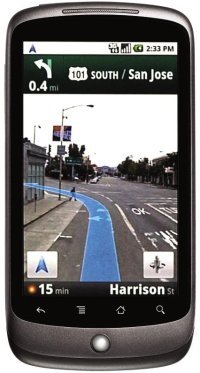Android 2.2 clobbers iPhone in JavaScript performance, review says
Jul 7, 2010 — by Eric Brown — from the LinuxDevices Archive — 1 viewsA Nexus One smartphone running Android 2.2 offers JavaScript performance that's two to three times faster than that of Apple's iPhone 4, says an ArsTechnica review. Android 2.2's Javascript performance is also almost three times faster than Android 2.1, beating Google's own estimates, but Flash performance is choppy, says the review.
 When Google announced Android 2.2 ("Froyo") in May, the Linux-based mobile operating system was touted by Vice President of Engineering Vic Gundotra as offering the "world's fastest mobile browser," with JavaScript performance claimed to be two to three times faster than Android 2.1.
When Google announced Android 2.2 ("Froyo") in May, the Linux-based mobile operating system was touted by Vice President of Engineering Vic Gundotra as offering the "world's fastest mobile browser," with JavaScript performance claimed to be two to three times faster than Android 2.1.
Now, ArsTechnica has published benchmarks that confirm this, claiming that JavaScript performance is indeed three times faster than with Android 2.1. In addition, Froyo running on Google's HTC-manufactured Nexus One is said to leave the iPhone 4 and its Safari browser in the dust.
The benchmarks compare Froyo's JavaScript performance running on the Nexus One with Apple's iPhone 4 running iOS4. The tests are said to use the SunSpider benchmarks, as well as Google's V8 JavaScript benchmarks.
In ArsTechnica's recent review of Android 2.2 on the Nexus One, which was the first phone to receive the update, Ryan Paul touts the release for its "extremely noticeable performance boost." He also praises Froyo for "a handful of impressive new features, some minor user interface enhancements, and useful new APIs for developers." (See farther below for more highlights of the review.)
Yesterday, ArsTechnica ran JavaScript benchmarks on an Apple iPhone 4 running iOS4 and found the device to execute them much more slowly than Froyo. The Nexus One with Android 2.2 was benchmarked at 287 on the V8 test, or three times faster than the iPhone 4, the website says. In addition, the Nexus One rang up a score of 5,795.2 on SunSpider, said to be almost twice as fast as the iPhone 4.
The Froyo performance increases stem from the new high-performance JIT introduced in Android's Dalvik VM (virtual machine) runtime environment, as well as "deep optimizations" to the WebKit-based browser, writes Paul.
Even before Android 2.2 was announced, benchmarks were published by AndroidPolice, showing dramatic performance improvements over Android 2.1. Running the Linpack test, which primarily tests Dalvik VM performance, the website found that Android 2.2 running on a Nexus One generated 37.593 MFLOPs, compared to about 6.5 to 7 MFLOPs with Android 2.1, said the story.
Flash flub-ups
The Android 2.2 review praises the release for excellent performance, but finds Adobe's Flash 10.1 performance, to be a problem. "Embedded Flash content tends to have a detrimental impact on page scrolling performance," writes Paul, noting choppy scrolling and page drawing, especially when multiple Flash elements are in play. Fortunately, he continues, "you can configure the browser to not show Flash content by default."
By comparison, an eWEEK review of a beta version of Android 2.2 and Flash 10.1 on the Nexus One back in May found Flash to offer "surprisingly smooth" playback on the Nexus One. Flash also offers some nice power management features that ease the battery drain, said the review. On the other hand, Flash was said to be ridiculously slow to load.
The ArsTechnica review made no mention of slow load times, so this may have been fixed in the final release. However, it does criticize Flash for other glitches, such as not displaying the on-screen keyboard when a text input element is activated.
Batch updates, SD storage, and tethering
The review praises Android 2.2 for offering several useful new features, the best of which is said to be support for automatic and batch updates of apps. Paul also liked the ability to store applications on SD cards, although in the case of the Nexus One, the new features cannot completely mitigate the problems that are caused by the phone's "poor internal application storage capacity."
According to the review, the new Wi-Fi tethering feature for sharing the 3G connection worked fine. As noted in ArsTechnica's earlier review of HTC's Evo 4G, however, this hotspot feature quickly drains the battery.
Finally, the review was impressed with Froyo's new Cloud to Device Messaging (C2DM) framework, which allows external Web services to send push notifications over the air to Android handsets.
C2DM is smart enough, Paul notes, to allow cloud notifications trigger "Intents," which are defined as programmatic operations that are exposed by individual Android applications. Because Intents are "key components of Android's interprocess-communication (IPC) system," he continues, it offers capabilities somewhat equivalent to a network-transparent IPC channel. "It's an incredibly clever concept that offers a lot of flexibility," he adds.
All told, the Android 2.2 performance improvements alone "make it an important upgrade for Android enthusiasts," concludes Paul. The performance boost is the major factor behind "improved responsiveness and smoother interface transitions" that "really boost the user experience," he adds.
Availability
The ArsTechnica story comparing the JavaScript performance of Android 2.2 and iOS4 may be found here, and the full Android 2.2 review should be here.
This article was originally published on LinuxDevices.com and has been donated to the open source community by QuinStreet Inc. Please visit LinuxToday.com for up-to-date news and articles about Linux and open source.